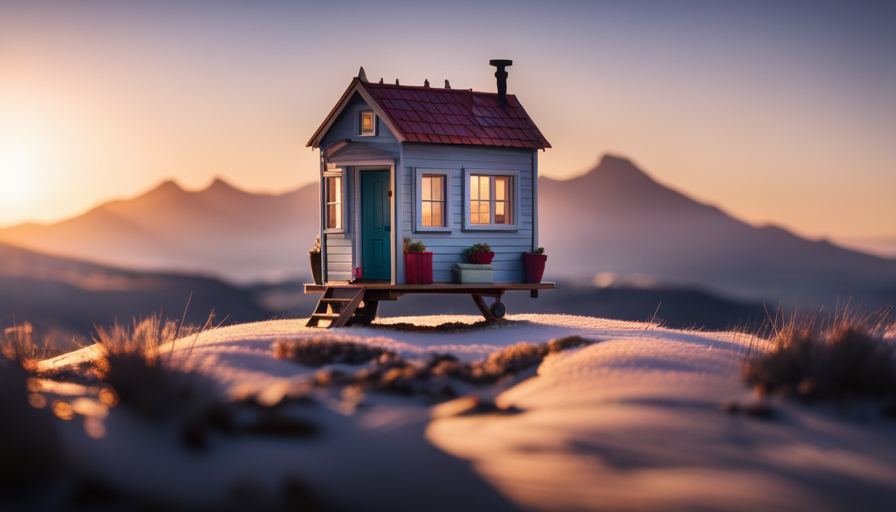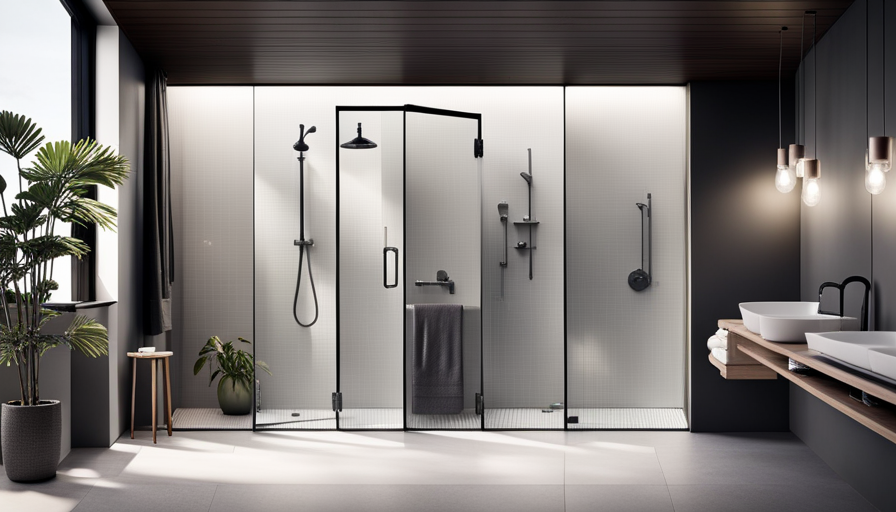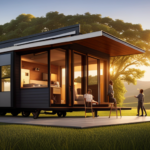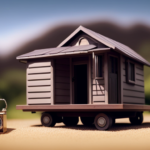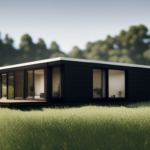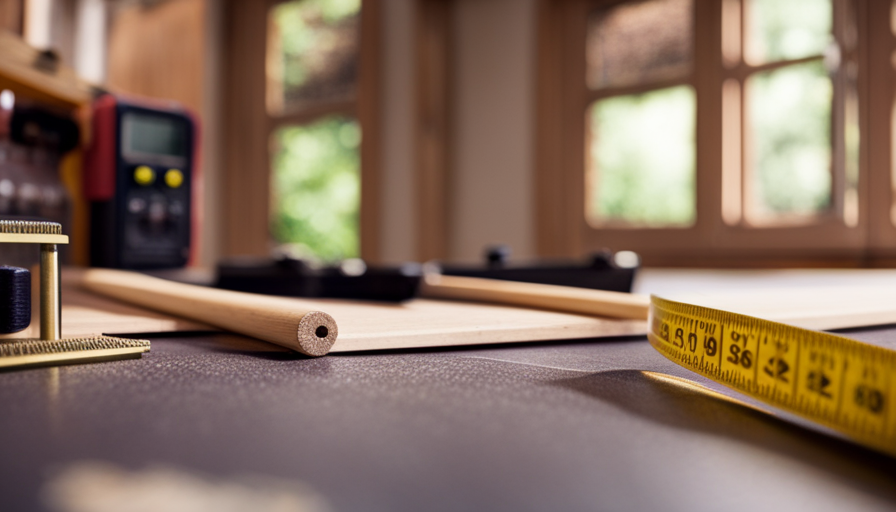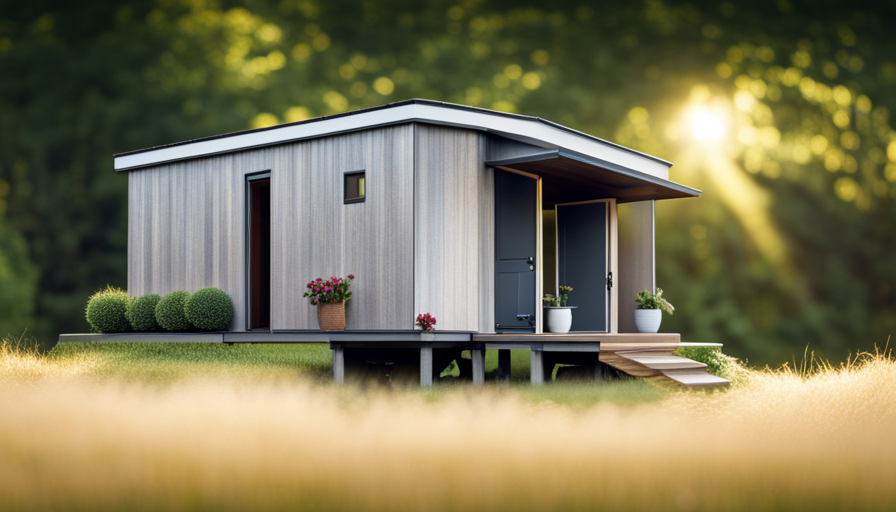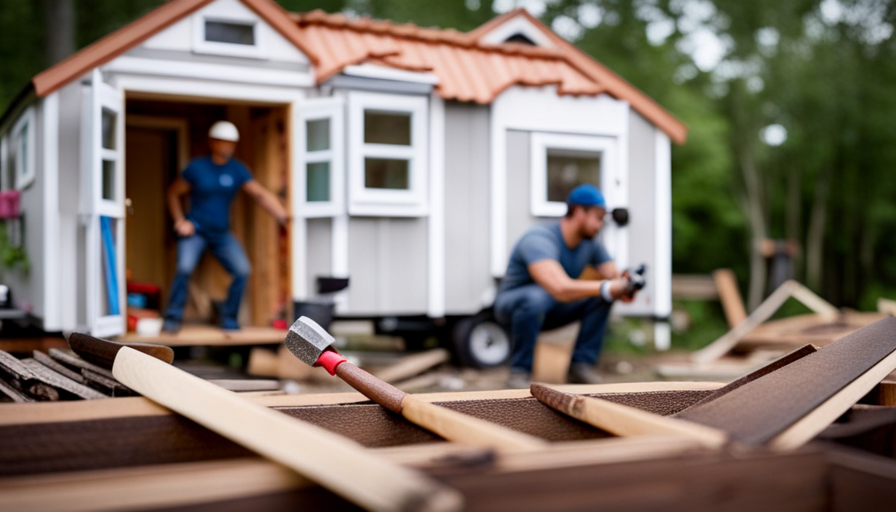As I gazed at a small house nestled amidst lush greenery, I realized that there is more to these tiny structures than meets the eye. Despite their size, the actual weight of a tiny house can vary greatly depending on various factors.
Imagine holding a feather and then trying to lift a brick. The difference in weight is undeniable, just as it is with tiny houses. From the construction materials used to the furnishings and appliances inside, every pound adds up.
In this article, we will delve into the intricate details of how many pounds a tiny house weighs. We will explore the impact of construction materials, size and dimensions, furnishings and appliances, water and plumbing systems, electrical systems and wiring, roofing materials, trailer weight for mobility purposes, additional features and customizations – all while keeping legal weight restrictions and transportation considerations in mind.
So fasten your seatbelts as we embark on this journey through the world of miniature living spaces!
Key Takeaways
- The weight of a tiny house can vary depending on construction materials, furnishings, and appliances.
- Construction materials such as engineered wood products and metal framing are used to reduce weight while maintaining strength and durability.
- Foam insulation is commonly used for its thermal performance and lightweight properties.
- Careful layout and design can optimize space usage and reduce unnecessary weight in a tiny house.
Understanding the Construction Materials Used
You might be surprised by how few pounds are needed to construct a tiny house using lightweight and innovative materials. When it comes to construction techniques for tiny houses, weight distribution is key.
These dwellings often utilize materials that prioritize strength and durability while minimizing weight. For example, instead of traditional lumber, engineered wood products like plywood and oriented strand board (OSB) are used, which weigh less but still offer structural integrity.
Additionally, many tiny houses incorporate metal framing to reduce weight while maintaining stability. Metal studs are lighter than wood ones and can be just as strong when properly engineered. Another technique employed is the use of foam insulation, which not only provides excellent thermal performance but also weighs significantly less compared to other insulation materials.
The impact of size and dimensions on the overall weight of a tiny house should not be underestimated either. By carefully designing the layout and optimizing space usage, unnecessary weight can be avoided. Furthermore, choosing efficient appliances and fixtures that are specifically designed for compact living can help reduce the overall poundage.
Constructing a tiny house involves employing construction techniques that prioritize weight distribution through the use of lightweight materials such as engineered wood products and foam insulation. Additionally, considering the impact of size and dimensions plays a crucial role in keeping the overall poundage low.
The Impact of Size and Dimensions
When considering the dimensions of a compact dwelling, its size can have a profound influence on various aspects. One key aspect affected by the size of a tiny house is mobility. Smaller houses are easier to transport and maneuver, making them more flexible in terms of location. This allows homeowners to change their surroundings or move their house easily if needed.
Additionally, the size of a tiny house has an impact on maximizing space. Every inch counts in these small dwellings, so careful consideration must be given to the layout and design. Clever storage solutions and multi-functional furniture are essential for utilizing every available space efficiently. By doing so, homeowners can create a comfortable living environment without compromising on functionality.
The size and dimensions of a tiny house significantly impact mobility and the ability to maximize space utilization. These factors contribute to the overall appeal and practicality of living in such compact dwellings.
Transitioning into the subsequent section about ‘furnishings and appliances,’ it is important to consider how these elements further enhance the functionality and comfort within a tiny home environment.
Furnishings and Appliances
Transform your compact dwelling into a cozy haven with carefully chosen furnishings and appliances that enhance comfort and functionality. When it comes to furniture weight, opt for lightweight options that aren’t only easier to maneuver but also reduce the overall load on your tiny house.
Consider multipurpose pieces like sleeper sofas or ottomans with hidden storage compartments to maximize space utilization. Additionally, collapsible tables and chairs can be stored away when they’re not in use, further optimizing your limited floor area.
To make the most of your small kitchen, invest in space-saving appliances. Compact refrigerators, dishwashers, and ovens are designed specifically for tiny houses while still providing all the necessary features. Look for appliances that are energy-efficient as well to minimize both electricity usage and environmental impact.
When selecting furnishings and appliances for your tiny house, prioritize functionality over aesthetics. Every item should have a purpose and contribute to the overall livability of your home. As you furnish your compact dwelling with lightweight furniture and space-saving appliances, you’ll create an inviting atmosphere without sacrificing convenience.
Transitioning into the next section about water and plumbing systems is crucial to ensure a comprehensive understanding of outfitting a tiny house for comfortable living without compromising essential utilities.
Water and Plumbing Systems
Enhance the comfort and functionality of your compact dwelling by outfitting it with efficient and reliable water and plumbing systems. In a tiny house, every drop of water counts, making water conservation a top priority. One way to achieve this is by installing low-flow fixtures such as faucets, showerheads, and toilets that use minimal amounts of water without compromising performance.
To effectively manage waste in your tiny house, consider installing a composting toilet system. These innovative systems break down human waste into nutrient-rich compost that can be safely used in gardening. Not only does this eliminate the need for traditional sewage systems, but it also helps reduce environmental impact.
Another important aspect of water and plumbing systems in a tiny house is proper storage and filtration. Installing a compact water tank allows you to store clean drinking water while conserving space. Additionally, incorporating a filtration system ensures that the water you consume is free from contaminants.
To provide more information on these efficient solutions for tiny houses’ plumbing needs, refer to the table below:
| Plumbing System | Description |
|---|---|
| Low-flow fixtures | Water-saving faucets, showerheads, and toilets |
| Composting toilet | Environmentally-friendly waste management solution |
| Compact water tank | Efficient storage for clean drinking water |
| Filtration system | Ensures safe consumption of filtered water |
By implementing these efficient water conservation methods and waste management solutions in your tiny house’s plumbing system, you can enjoy a comfortable living space while minimizing your ecological footprint. Transitioning into the subsequent section about ‘electrical systems and wiring’, let’s explore how to power your small abode efficiently without sacrificing convenience or safety.
Electrical Systems and Wiring
To ensure a seamless and efficient power supply, outfit your compact dwelling with a well-designed electrical system and wiring that seamlessly integrates into your living space. When it comes to electrical safety in tiny houses, there are several key considerations to keep in mind:
-
Proper grounding: Ensure that your electrical system is properly grounded to reduce the risk of electric shock and protect against power surges.
-
Circuit protection: Install circuit breakers or fuses to prevent overloading and short circuits, which can lead to fires or damage to appliances.
-
Energy-efficient lighting: Opt for LED lights instead of traditional incandescent bulbs to save energy and reduce electricity consumption.
-
Solar power options: Consider utilizing solar panels to harness clean and renewable energy, reducing reliance on the grid and decreasing utility costs.
In addition to these safety measures, maximizing energy efficiency is crucial in a tiny house where every watt counts. Choose energy-efficient appliances, insulate walls and ceilings properly, seal any air leaks around windows and doors, and consider installing programmable thermostats for precise temperature control.
Transitioning into the subsequent section about insulation and weatherproofing, it’s essential to create an energy-efficient envelope that minimizes heat loss or gain while maintaining a comfortable indoor environment without excessive reliance on heating or cooling systems.
Insulation and Weatherproofing
Creating a cozy and energy-efficient living space starts with proper insulation and weatherproofing to ensure that your home stays comfortable all year round. Insulation techniques play a crucial role in maintaining the desired temperature inside your tiny house while minimizing energy consumption. By effectively insulating your walls, floors, and ceilings, you can prevent heat transfer and reduce the need for excessive heating or cooling systems.
To achieve optimal insulation, there are various materials you can use. For walls, options like fiberglass batts or rigid foam boards provide excellent thermal resistance. Floor insulation can be achieved through spray foam or rigid foam panels installed between floor joists. Lastly, for the roof, consider using reflective foil barriers to minimize heat gain during summer months.
In addition to insulation techniques, weatherproofing is equally important to protect your tiny house from external elements. Caulking and weatherstripping should be used around windows and doors to seal any gaps that may allow air leakage or moisture penetration.
By implementing these insulation and weatherproofing strategies, you can significantly improve energy efficiency within your tiny house. This not only helps reduce utility costs but also minimizes environmental impact by lowering overall energy consumption.
Transitioning into the subsequent section about roofing materials and weight, it’s essential to consider how different roofing materials can affect the overall weight of your tiny house without compromising its structural integrity.
Roofing Materials and Weight
Consider using lightweight roofing materials such as metal or asphalt shingles, which can reduce the overall weight of your roof by up to 40%, allowing for easier transportation and a more structurally sound tiny house. When choosing the right roofing options for your tiny house, it’s essential to consider weight distribution. The weight of the roof plays a significant role in maintaining stability while on the move.
By opting for lightweight materials like metal or asphalt shingles, you can significantly decrease the load on your trailer. Metal roofing is an excellent choice due to its durability and low weight. It offers exceptional strength-to-weight ratio, making it ideal for tiny houses with limited load capacity. Additionally, metal roofs are highly resistant to extreme weather conditions and require minimal maintenance.
Asphalt shingles are another popular option that provides both affordability and versatility. These shingles are lightweight compared to other roofing materials while still offering adequate protection against rain, wind, and snow. They come in various styles and colors, allowing you to customize your tiny house’s appearance.
By carefully selecting lightweight roofing materials like metal or asphalt shingles, you can ensure that your tiny house remains structurally sound while minimizing trailer weight. This will enhance mobility during transportation without compromising on safety or aesthetic appeal when transitioning into the subsequent section about ‘trailer weight and mobility.’
Trailer Weight and Mobility
Achieving optimal mobility and ease of transportation is crucial for ensuring the smooth journey of your compact dwelling.
To achieve this, it’s important to consider the trailer size and towing capacity of your tiny house. Here are four key points to keep in mind:
-
Trailer Size: Choosing the right size trailer is essential for a tiny house on wheels. The length and width of the trailer should be carefully selected based on your specific design requirements. It should be spacious enough to accommodate all the necessary amenities while still being compact and manageable.
-
Towing Capacity: Understanding the weight limits that your vehicle can safely tow is vital when selecting a trailer for your tiny house. Consider factors such as the weight of your fully furnished home, including appliances, furniture, and personal belongings, along with any additional features or customizations you may desire.
-
Stability: Ensuring stability during transportation is crucial to prevent any accidents or damage to your tiny house. Properly distributing weight on the trailer, using stabilizer jacks, and securing all items inside will help maintain balance and reduce sway while on the road.
-
Maneuverability: A lightweight trailer will make towing easier and less stressful. Consider materials like aluminum or composite that offer durability without excessive weight.
By carefully considering these factors related to trailer size and towing capacity, you can ensure safe mobility for your tiny house on wheels.
Transitioning into discussing additional features and customizations without writing ‘step’, it’s also important to consider other aspects that enhance both functionality and aesthetics within your compact living space.
Additional Features and Customizations
When outfitting your compact dwelling, don’t forget to explore the endless possibilities of adding unique features and customizations. The interior design of a tiny house is crucial in maximizing the limited space available. With clever planning and innovative ideas, you can create a functional and aesthetically pleasing environment.
Storage solutions are particularly important in a tiny house, as every inch counts. Utilizing vertical space with built-in shelving and utilizing multi-purpose furniture like storage ottomans or beds with hidden compartments can greatly enhance the organization and functionality of your living area.
Customization options for a tiny house are virtually limitless. From selecting the perfect color scheme to choosing eco-friendly materials, you have complete control over designing your dream home. Some popular customizations include installing solar panels for off-grid living, incorporating smart home technology for added convenience, or even adding a rooftop garden for sustainable food production.
As we delve into legal weight restrictions and transportation considerations, it’s essential to ensure that all additional features and customizations do not exceed the maximum weight limit allowed for towing on roads. By carefully considering the weight of each customization during the design phase, you can ensure that your tiny house remains within legal limits while still reflecting your personal style and preferences.
Legal Weight Restrictions and Transportation Considerations
To ensure you can safely transport your compact dwelling, it’s crucial to be aware of the legal weight restrictions and transportation considerations that may impact your journey. When it comes to tiny houses, there are specific legal regulations in place regarding their weight for road safety purposes.
Here are some important points to keep in mind:
-
Maximum Weight Limit: Each state has its own maximum weight limit for towing or transporting a tiny house on public roads. It’s essential to research and adhere to these limits to avoid any legal issues or potential accidents.
-
Axle Requirements: The number of axles and the distance between them play a significant role in distributing the weight evenly. Adhering to axle requirements ensures stability during transportation.
-
Permits and Escorts: Depending on the size and weight of your tiny house, you may need special permits or escorts for transportation. These permits help authorities monitor oversized loads, ensuring road safety.
-
Proper Hitching Systems: Choosing the right hitching system is crucial for securely attaching your tiny house to a vehicle. Make sure it meets all necessary safety standards.
By understanding and following these legal regulations and road safety guidelines, you can ensure a smooth and safe journey while transporting your tiny house.
Frequently Asked Questions
Are there any regulations or permits required for building a tiny house?
No regulations or permits are required for building a tiny house. It’s a free-for-all! You can construct your little dream home without any pesky rules holding you back.
No need to worry about safety standards, zoning laws, or environmental impact assessments. Just grab some tools and get to work!
Who needs regulations when you have the freedom to build whatever you want, wherever you want? It’s anarchy in the world of tiny houses! (70 words)
How much does it cost to build a tiny house?
To build a tiny house, cost considerations are essential. Factors such as location, size, and design affect the overall expense. Generally, materials needed include lumber, insulation, roofing materials, windows, doors, and utilities like plumbing and electrical systems.
Costs can vary widely depending on quality choices and individual preferences. It’s advisable to create a detailed budget plan before starting construction to ensure efficient use of funds and minimize unexpected expenses.
Can a tiny house be moved to a different location easily?
Yes, a tiny house can be moved to a different location easily due to its portability. The transportation logistics of moving a tiny house involve careful planning and considerations for weight restrictions, road accessibility, and the use of specialized equipment such as flatbed trailers or tow trucks. With proper preparation and coordination, relocating a tiny house can be accomplished efficiently and without much difficulty.
What are the pros and cons of living in a tiny house?
Living in a tiny house has both pros and cons. On the positive side, it offers a sense of freedom and minimalism, allowing for a simpler and more intentional lifestyle. It can also lead to increased sustainability, as smaller spaces require less energy and resources.
However, challenges arise when downsizing, as it can be difficult to part with belongings. Additionally, the limited space may impact mental health by causing feelings of claustrophobia or isolation.
Are there any financing options available for building a tiny house?
Tiny house financing options include personal loans, RV loans, and construction loans. Personal loans are typically unsecured and have higher interest rates but can be used for various expenses.
RV loans are secured by the tiny house itself and often offer lower interest rates.
Construction loans provide funding specifically for building a tiny house and are usually based on the projected cost of construction.
These loan options allow individuals to secure financial assistance for building their dream tiny house.
Conclusion
As I carefully calculated all the various components and factors that contribute to the weight of a tiny house, I couldn’t help but feel a sense of anticipation building within me.
The intricate balance between construction materials, furnishings, appliances, water and plumbing systems, electrical wiring, roofing materials, and even additional features and customizations is astonishing.
But the true challenge lies in understanding the legal weight restrictions and transportation considerations. It’s like unraveling a mystery with each piece adding depth and complexity to the overall picture.
And so, as I conclude my exploration into the lbs of a tiny house, I’m left in awe of its intricacies and possibilities.
Hi, I’m Emma. I’m the Editor in Chief of Tiny House 43, a blog all about tiny houses. While tree houses are often associated with childhood, they can be the perfect adult retreat. They offer a cozy space to relax and unwind, surrounded by nature. And since they’re typically built on stilts or raised platforms, they offer stunning views that traditional homes simply can’t match. If you’re looking for a unique and romantic getaway, a tree house tiny house might just be the perfect option.
